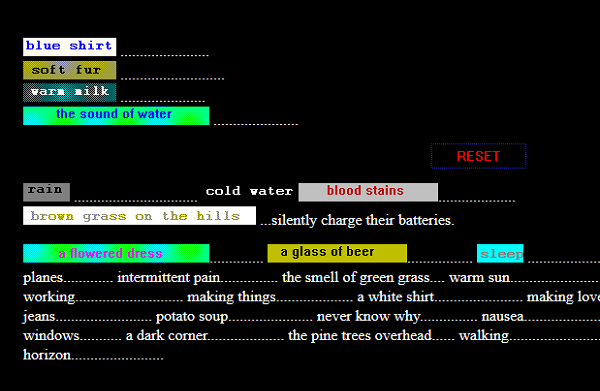
"...Malloy's most technically and visually sophisticated work for the web to date, while carrrying on her hallmark tradition of intense, compact writing" - Richard Kostelanetz, A Dictionary of the Avant-Gardes, Routledge
Twenty years ago, in 1996, lexias from The Roar of Destiny began appearing on the fledging World Wide Web. The Twentieth Anniversary edition, created in the spring of 2016, celebrates this early-web-reflective work by retaining the look and feel in a more contemporary environment.
In 1995 when I began writing The Roar of Destiny, the World Wide Web was relatively new. This work was a poetic response to an era when the lives of those of us -- who worked virtually and thus spent days and nights online -- were altered, as black & white, green & black or yellow & black text metamorphosized into vibrant dense arrays of competing information, and virtual communities were displaced by moated castles in a sea of entrancing new work.
Described by interactivecinema.org as "...a perfect example of thought and physical interaction working together... ", The Roar of Destiny is an electronic manuscript constructed with with hundreds of carefully crafted, intertwined lexias. The reader, like the narrator, is involved in a continual struggle between the real and the virtual -- between stark black-backgrounded paths that lead to despair and depression and bluegreen-backgrounded paths that follow beside clear mountain streams; between purple screens that relate the narrator's sojourn in a desert home and white screens that detail the relationships between co-workers in a virtual workspace.
The primary interface in this experience of environment and altered environment is a dissolving and reassembling dense structure of phrase links. Radiating from this structure, are poem-bearing lexias -- each composed of a narrative fragment that sometimes runs decisively in the center of the screen and sometimes is raggedly merged with peripheral words and hyperlinked phrases. The reader follows the narrative by reading the bolded words in the narrative lexias -- while at the same time absorbing the peripheral words and links in the way that one views the links in online newspapers.
With the exception of small edits and occasional altered linking, the text remains the same, but narrarray, the authoring system I wrote for this work, produces a version that more clearly emphasizes the hypertextual arrays with which this electronic manuscript is composed. And, interspersed in the whole are lexias with audio readings, a practice that began in 2014 when John Barber invited me to contribute sound to radioELO. To create the audio readings, the lexias are used as an unmeasured scores, where the peripheral words are read in counterpoint or harmony with the main line of melody.
As the reader explores the work, they appear as
unexpected surprises.
Or, they can be played as follows:
merged with the screen for days
black beans, sardines, asparagus soup
Bring home a pizza," I whispered.
an otherworldly glass of beer
four crystal goblets unexpectedly at midnight
"from lands equally distant"
on the screen of my Toshiba T3400
Midnight and @who divulged only Mary
remembering champagne
on the meadow above the creek